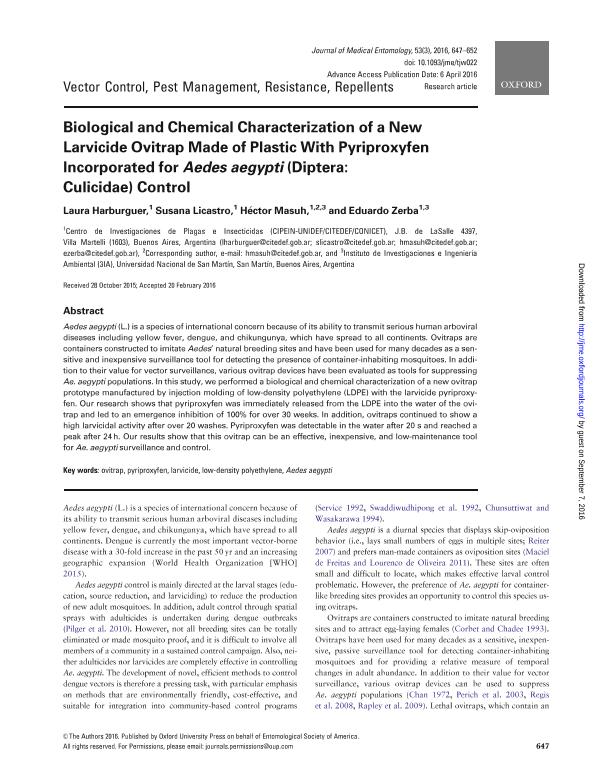Artículo
Biological and Chemical Characterization of a New Larvicide Ovitrap Made of Plastic With Pyriproxyfen Incorporated for Aedes aegypti (Diptera: Culicidae) Control
Fecha de publicación:
04/2016
Editorial:
Entomological Society of America
Revista:
Journal of Medical Entomology
ISSN:
0022-2585
Idioma:
Inglés
Tipo de recurso:
Artículo publicado
Clasificación temática:
Resumen
Aedes aegypti (L.) is a species of international concern because of its ability to transmit serious human arboviral diseases including yellow fever, dengue, and chikungunya, which have spread to all continents. Ovitraps are containers constructed to imitate Aedes? natural breeding sites and have been used for many decades as a sensitive and inexpensive surveillance tool for detecting the presence of container-inhabiting mosquitoes. In addition to their value for vector surveillance, various ovitrap devices have been evaluated as tools for suppressing Ae. aegypti populations. In this study, we performed a biological and chemical characterization of a new ovitrap prototype manufactured by injection molding of low-density polyethylene (LDPE) with the larvicide pyriproxyfen. Our research shows that pyriproxyfen was immediately released from the LDPE into the water of the ovitrap and led to an emergence inhibition of 100% for over 30 weeks. In addition, ovitraps continued to show a high larvicidal activity after over 20 washes. Pyriproxyfen was detectable in the water after 20 s and reached a peak after 24h. Our results show that this ovitrap can be an effective, inexpensive, and low-maintenance tool for Ae. aegypti surveillance and control.
Palabras clave:
Ovitrap
,
Aedes Aegypti
,
Pyriproxifen
,
Larvice
Archivos asociados
Licencia
Identificadores
Colecciones
Articulos(UNIDEF)
Articulos de UNIDAD DE INVESTIGACION Y DESARROLLO ESTRATEGICOS PARA LA DEFENSA
Articulos de UNIDAD DE INVESTIGACION Y DESARROLLO ESTRATEGICOS PARA LA DEFENSA
Citación
Harburguer, Laura Vanesa; Licastro, Susana Mónica; Masuh, Hector Mario; Zerba, Eduardo Nicolás; Biological and Chemical Characterization of a New Larvicide Ovitrap Made of Plastic With Pyriproxyfen Incorporated for Aedes aegypti (Diptera: Culicidae) Control; Entomological Society of America; Journal of Medical Entomology; 53; 3; 4-2016; 647-652
Compartir
Altmétricas




